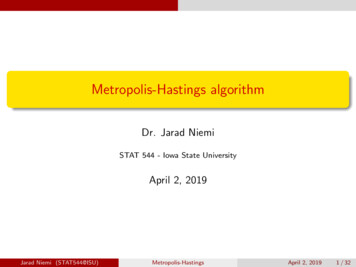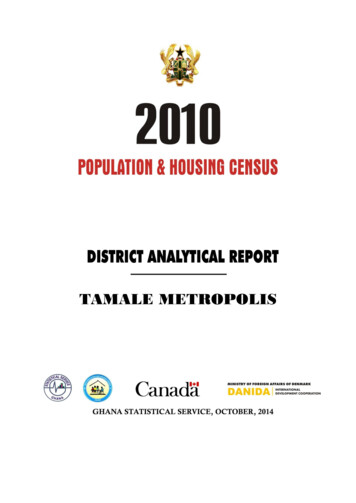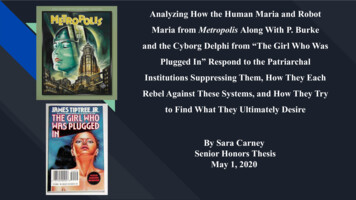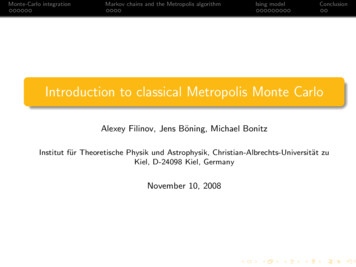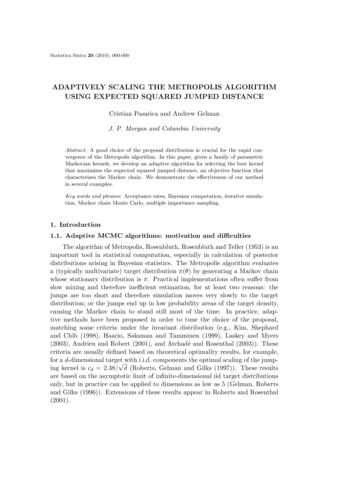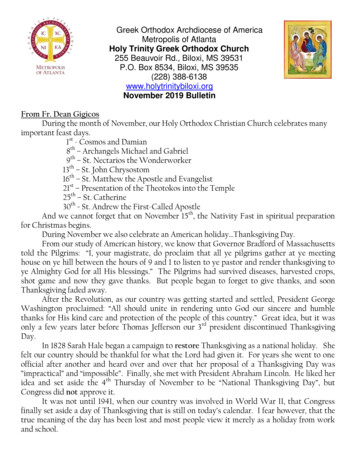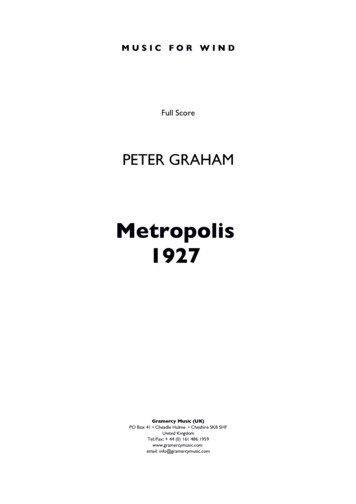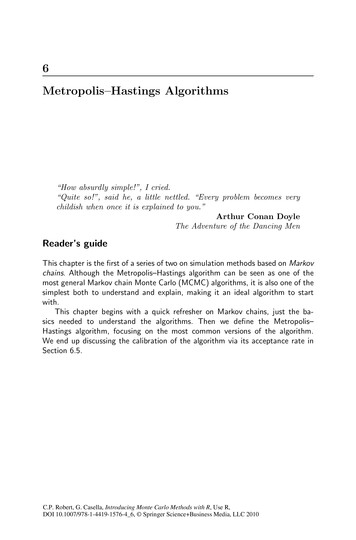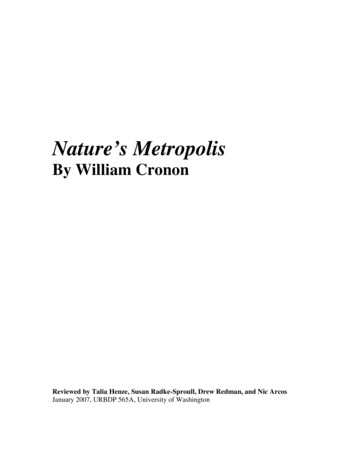
Transcription
Nature’s MetropolisBy William CrononReviewed by Talia Henze, Susan Radke-Sproull, Drew Redman, and Nic ArcosJanuary 2007, URBDP 565A, University of Washington
Author biographyWilliam Cronon is a history, geography, and environmentalstudies at professor at the University of Wisconsin inMadison where he is holds the title of Frederick JacksonTurner and Vilas Research Professor. He has committedhimself to understanding “the history of human interactionswith the natural world” 1 by publishing a number of relatedmajor works and articles and also by involving himself in avariety of pertinent organizations. He currently teachescourses on geography, environmental history, and the American west.He first book, Changes in the Land: Indians, Colonialists, and the Ecology of NewEngland, which examined the passing of New England’s landscape from Indian tocolonial control, was awarded the 1983 Frances Parkman Prize. In 1992, after Nature’sMetropolis, he co-edited a collection of essays entitled, Under an Open Sky: RethinkingAmerica’s Western Past. Most recently, in 1995, he published his own collection ofessays, Uncommon Ground: Rethinking the Human Place in Nature. This book includedhis essay "The Trouble with Wilderness, or, Getting Back to the Wrong Nature," inwhich he proposes a controversial definition of wilderness that is not completely walledoff from that which is human. 2Nature’s Metropolis was nominated for a Pulitzer Prize in History, and was awarded aChicago Tribune’s Heartland Prize, a Bancroft Prize, a George Perkins Marsh Prize fromthe Society for Environmental History, and a Charles A. Weyerhaeuser Award from theForest History Society.Dr. Cronon acts as the general editor for Weyerhaeuser Environmental Books Series forthe University of Washington Press, and he serves on the editorial board for a number ofhistorical and environmental journals. He is also a member of the National Board for theTrust for Public Land and part of the Governing Council for the Wilderness Society. Hehas also served as president of the American Society for Environmental History.Throughout his academic career, he was a history professor at Yale University and wasthe recipient of a Rhodes Scholarhip, and Danforth, Guggenheim, and MacArthurFellowships.Dr. Cronon is the child of a historian. He has said, “almost every question I had abut theworld included asking how things got to be this way.” 3 He has devoted his life toacademic pursuits, ferreting out and crafting the larger significance of our historicalrelationship with the environment. In a plenary address to the Land Trust Alliance Rallyin 2005, he said, “land conservation protects nature. But it also protects community anddemocracy and our core values as a nation. 4 ”1Cronon’s website, Jan 28: http://history.wisc.edu/cronon/Biography.htm“An Interview with William Cronon,” Scapes (Parsons New School for Design, Department ofArchitecture, Interior Design, and Lighting), 5 (Fall 2006), 34-45.3“An Interview with William Cronon.”4Cronon's Plenary Address to the 2005 Land Trust Alliance Rally22
Critical receptionNature’s Metropolis, written by William Cronon, was published in 1991. Reviews of thework appeared in journals and periodicals ranging from The New Yorker to economicjournals, from design-focused Metropolis to the scholarly Annals of the Association ofAmerican Geographers, from publications that explore American History as a qualitativesubject to publications that embrace geography to apply quantitative analysis tounderstanding patterns in history.Reviewing the book in 1992 as a work of American history, Peter Coclanis’ review 5 canbe viewed as a wounding personal attack on Cronon’s work, in both style and content, ora breath of fresh air, depending on the point of view: At the same time accusing Crononof a tendency, across his works, to drift “into (Birken-)stock condemnations ofaccumulation,” Conclanis does find the book to achieve a certain level of originality thatshould be praised. Additionally, he gives accolades for the fine details that Cronon’sbook achieves in Chapter 2 through 7. Conclanis expresses an appreciation for theresearch and links that Cronon completes.However, in Conclanis’ view, the author’s faults are too overwhelming to be ignored.Most of these faults center on a certain “smugness of tone” and “self-importance” asCronon introspects in the early and closing chapters. Further, Conclanis accuses Crononof ignoring entire disciplines (development economics, regional sciences, etc.) andparallel industrial activities in Chicago (foundry and machining, clothing and apparel,and manufacture of tobacco products) that would balance the story. Moreover, he takesissue with Cronon’s “introduction” of models such as von Thumen’s circles withoutgiving due credit for the extent to which they have dominated the field of regionaldevelopment for decades.Ultimately, Conclanis feels that Cronon’s work is too greatly flawed in content and styleto praise as a worthwhile representation of Chicago’s history of development. (Some ofthis review seems to be less than objective. Cronon himself at the outset of the bookemphasizes that the book is not intended to be a history of Chicago’s development. ed.)Writing in the same year for the journal for the Society for the History of Technology,Technology and Culture, Carl W. Condit had a slightly more positive view 6 . Overall,Condit commended Nature’s Metropolis as a valuable contribution to urban history, butfelt that Cronon focused too much on entrepreneurs, and not enough on economic,material, and cultural history. Condit praises the narrative as ‘rich and lively’ and largelyagrees with Cronon’s premise that that Chicago and its hinterlands grew together in a“natural-cultural symbiosis of prairie agriculture, forest lumbering, city enterprises,canals, and railroads.”However, Condit criticizes Cronon for missing crucial aspects of Chicago’s geography indetermining its regional status: abundant iron ore in Michigan and Minnesota and coal in5Colcanis, Peter A. “Urbs in Horto.” Review of Nature’s Metropolis: Chicago and the Great West, byWilliam Cronon. Reviews in American History 1992 20 (Mar): 14-20.6Condit, Carl W. Technology and Culture, Vol. 33, No. 3. (Jul., 1992), pp. 591-593.3
Illinois and Indiana. These two minerals guaranteed the concentration of wealth andrailways in Chicago. Also, cultural aspects like the Chicago Symphony Orchestra, theField Museum of Natural History, libraries, the Art Institute, and the University ofChicago were overlooked in Cronon’s discussion of the World Expo: “The civic creationsof the 1890’s can and should have been integrated with the material on the world’sfair ”These criticisms contrast with a review by Verlyn Klinkenborg, himself an acclaimedauthor and essayist, in The New Yorker in 1991. 7 The enthusiastic tone of his reviewinvites readers to plunge into Cronon’s “rare historical work which treats nature and themoral force we derive from it seriously without lapsing into tendentiousness and withoutharming the quality of its historical analysis.” In particular, Klinkenborg’s imagination iscaptured by Cronon’s description of the commercialization of “first nature” (“thenonhuman world of ecological relations”) into commodities (lumber, grain, and meat).Klinkenborg reflects his own enthusiasm by devoting most of the text of his review todelivering the message of the book, presumably as a way of encouraging his audience todive in. Klinkenborg ends his review with what appears to be Cronon’s final message aswell: the city and the country are inextricably linked, the welfare of one is bound in thewelfare of the other, and we should be systematically taking better care of both.Similarly, C. F. Runge, in a 1993 issue of Land Economics, 8 embraces Cronon as an“environmental historian” who “cares deeply for the environment” and uses Chicago as asymbol to explore the “impact of market forces on the faces of nature.” Runge’s reviewof the book is strongly positive, concluding that in Cronon’s book are lessons for theeconomist who fails to see the link between economic and market expansion and thedepletion of the very resources that made that expansion possible.7Klinkenborg, Verlyn. “Boosted.” Review of Nature’s Metropolis: Chicago and the Great West, byWilliam Cronon. The New Yorker 1991 (July): 77-79.8Runge, C. F. Review of Nature’s Metropolis: Chicago and the Great West, by William Cronon. LandEconomics 1993 69(1) (Feb): 116-118.4
Contextualizing the workIn a recent interview, Cronon, a leading figure in environmental history, stated that his isa relatively new subject of research, dating only to the 1970s. 9 So, while it is good tolook at Cronon’s work in the context of his contemporaries, it is also necessary to take aquick look at older schools of thought which provoke the environmental historian’sreactionFrederick Jackson Turner, 1861 – 1932, provides us with a perfect portal to thelatter school of thought. Turner had an enormous impact on the history of theAmerican west. What historians refer to as the “Frontier Thesis” or the “TurnerThesis” is outlined in one of his most famous essays, “The Significance of theFrontier in American History,” published in 1893 and delivered in a lecture at theChicago World’s Fair. 10 In a brief review of a number of works on the westernfrontier, Turner’s is the thesis against which many historians measure their ownarguments. Since 1947, there has even been a professorship at the University ofWisconsin Madison named after him. It is a small measure of irony that William Cronon,currently the Frederick Jackson Turner Professor at this university, spends a good numberof pages at the beginning of Nature’s Metropolis addressing and rebutting Turner’scontribution to and influence over the subject of frontier expansion in the American west.Turner’s theory is that savage wilderness is slowly taken up in progressive stages by ruralpursuits and increasingly intense agriculture uses that result in increasingly urbansettlements. 11 Cronon and his contemporaries, including Robert Wade, make the casethat settlement of the American west was not the result of a Turner-like evolution along ahierarchy from wild to urban; rather, in Cronon’s vision, western evolution of city andcountry occurred concurrently and in intricate tandem.Robert Wade, in his 1959 work, The Urban Frontier: The Rise of WesternCities, 1790 – 1830, turned the Turner thesis inside out by arguing thatcities, funded by advance investments in boom times, were the entitieswhich sparked agricultural economies (in turn supporting the economicstructure of the cities 12 .) Wade broadly outlines of the nascent efforts ofPittsburg, Cincinnati, Lexington, Louisville and St. Louis to establishearly “frontier” urban locales, each consciously modeling an already9“An Interview with William Cronon,” Scapes (Parsons New School for Design, Department ofArchitecture, Interior Design, and Lighting), 5 (Fall 2006), 34-45.10Online Wikipedia entry on Frederick Jackson Turner, viewed on January 27, 2006at: http://en.wikipedia.org/wiki/Frederick Jackson Turner11Nature’s Metropolis, pp. 46-54.12H-Urban Book Reviews by Carl Abbott, Portland State University, “Abbott on Wade, Urban FrontierReview,” viewed January 28 at http://h-net.msu.edu/cgi-bin/logbrowse.pl?trx vx&list henvironment&month 9707&week e&msg eI2f247HrpMGft3mjRRwYQ&user &pw and by JamesWunsch, Empire State College, “Wade’s frontier,” viewed January 28 at http://h-net.msu.edu/cgibin/logbrowse.pl?trx vx&list hurban&month 9706&week a&msg yL//3tK5cN0lm%2bao7Wh%2bAA&user &pw 5
established coastal city. “In each area, urban leadership built up trade and industry andalso supplied the impulse and economic support for civilization and culture.” 13 Wadeappears to be associated with the poignant anti-Turner argument that the advance ofwestern settlement was not a ‘natural,’ practically pre-ordained evolution, but the resultof a more aggressive pursuit of economic and commercial expansion. Cronon takes up asimilar historical perspective. Wade and Cronon also express similar thoughts on theintegrated histories of both urban and rural landscapes.In Nature’s Metropolis, Cronon recognizes Donald Worster as having influenced hiswork. Worster published Nature’s Economy: A History of Ecological Ideas in1977; it was republished in 1985 and 1994. In an attempt to uncover “the roots ofour contemporary perception of nature,” Worster reviews the history of ecology infive stages. He starts with 18th century romantic relationships to nature and ends inan analysis of the contemporary evolving rivalry between notions of ecosystems andan “organicist” approach. 14 At a time when the subject of environmental historywas in its early phases, Worster provided a thoughtful guide through the fluctuations inour perception of the natural world. Cronon uses a similar approach in his carefultreatment of “first” and “second” natures in Metropolis.These three examples only give a small representative of Cronon’s contemporary context;Cronon himself lists many other examples. In Nature’s Metropolis, he recognizes theinfluence of Michael Conzon (who wrote historical geographies on metropolitandominance), Patty Limerick (a fellow Turner critic), and Allan G. Bogue (who wroteabout the political and economic forces that shape agriculture). For their particularinfluence in linking human and natural history, Cronon has also cited 15 : Aldo Leopold, The Sand Country Almanac Rachel Carson, Silent Spring George Perkins Marsh, Man and Nature Carl Sauer, Man’s Role in Changing the Face of the Earth, and Raymond Williams, The Country and the City, and in particular, his essay“Ideas of Nature” in Problems of Materialism and Culture.13Catherine E. Reiser, “Untitled Review of The Urban Frontier: The Rise of Western Cities, 1790 – 1830by Richard C. Wade.” The Mississippi Valley Historical Review, Vol 46. No.3 Dec 1959, pp 507-509.14From Nature’s Economy, quoted in an untitled book review by J. Sheail, Journal of Ecology, Vol. 83,No. 3 (June, 1995), pp. 556-557.15“An Interview with William Cronon,” Scapes (Parsons New School for Design, Department ofArchitecture, Interior Design, and Lighting), 5 (Fall 2006), 34-45.6
Outline of the BookPreface: Understanding the book A dozen years in the making Started as doctoral dissertation Myriad sources Historical accounts Chicago guidebooks and booster flyers Patterns of newspaper subscriptions: in 1834, ¾ were mailed outsidethe city Land ownership and bankruptcy records Railroad company books Commodity receipts Author’s goals Present a history: not a history of Chicago, or of the Great West, but a history ofthe relationship between them Explore century-old economic and ecological transformations that continue toaffect all of North America Tell the city-country story as a unified narrative Explore environmental change in relation to the actions of human beings Combine economic and environmental history in a way that will excite Reflect on our collective future Book’s structure Organize the book around commodity flows Understand environmental change in relation to the actions of humanbeings Present a series of stories, each tracing the path between an urban market andthe natural systems that supply it Present a series of historical journeys between city and country in an effort tounderstand the city’s place in nature Underlying premises No city played a more important role in shaping the landscape & economy of themid-continent during the second half of the nineteenth century than Chicago One cannot understand the growth of Chicago without understanding its specialrelationship to the vast region lying to its west In Chicago’s story is the starting point for today’s environmental problems City and country have a common history, so their stories are best told together Few economic institutions more powerfully affect human communities andnatural ecosystems in the modern capitalist world than commodity markets Commodities that feed, clothe, and shelter us are among our most basicconnections to the natural world Key terms Great West: from Lake Michigan all the way to the Pacific Ocean Frontier: areas on the periphery of the metropolitan economy7
Nature First nature: original, un-constructed worldSecond nature: artificial nature erected atop first nature8
Prologue: Questions to ponder about the “Cloud over Chicago” Where is the line between “natural” and “unnatural?” Is it the same as between “country” and “city?” Is the line at untouched hinterlands? Plowed fields, farms, woodlots, agriculturalcountryside? Second-growth forests? Streets, buildings, parks? Can city and country be treated as isolated places? Could farms survive without the cities? Could cities survive without the crops delivered by the farms? Can people truly build a world for themselves apart from nature? Is the city “august as well as terrible?” Is Chicago proof that the US is, indeed, “nature’s nation?” Is Chicago proof of the triumph of human will over natural adversity, a “wonderof nature transformed?” Have the same forces that created the city robbed its citizens of their humanity? Is one “curiously alone” from values that give human life larger meaning:closeness to neighbors, a sense of rootedness in the soil, a feeling of belonging? Does living in such a place risk putting human creation above the works of God? Part I of the book lays the groundwork for understanding subsequent environmentalchanges Tallgrass prairies give way to cornstalks and wheat fields White pines of the north words become lumber Vast herds of bison die to make room for more manageable livestockSources: 20 sources, mostly novels or essays in which Nature, city, and country aredepicted9
Part I: To be the Central City – Chapter 1: Dreaming the Metropolis Patterns on a Prairie Landscape: metropolitan history begins with geography Chicago “the wild garlic place” was first defined by its geography: rich glacialsoil, natural harbor, river access, borderland between western prairies andeastern forests 1770’s: fur-trading post 1830: vast trading network, prosperous but small 1833: beginning of Chicago’s metropolitan history Chicago more thandoubled population, became center of the most intense land speculation inAmerican history Booster Dreams: theories of economic growth that dominated 19th century thinking Boosters worked from a surprisingly coherent model of urban and regionalgrowth: symbiotic relationship between cities and their surrounding countryside Believed that big profits came from town sites, not agricultural land Believed that features of the landscape pointed toward key locationsthat nature had designed for urban greatnesso Regional resources that would center the region’s trade on thecityo Natural transportation routes (and their evolution)o Climatic forces (temperate zone) Goodin’s gravitational theory (forerunner of central place theory): cities hadtheir roots in natural phenomena but ultimately grew because people chose tomigrate to them Rural populations clustered around small villages, which clusteredaround larger towns, which clustered around still larger cities to anultimate central metropolis the ultimate spatial arrangement ofhuman beings Drove careful quantitative analysis, e.g., of census and demographicdata, to predict where the ultimate central city would arise Speculators gambled on an urban future, without Chicago passing through a“pastoral stage” of agriculture or small town Metropolis and Empire: new model of the relationship between a city and itshinterlands America’s cities would grow by commercial power, not military might: thecentral metropolis would be the center of a commercial empire wherein the flowof “tribute” would enrich all and impoverish none Reading Turner Backward: two views of the Great West are two sides of the samecoin Boosters’ vision of the future: urban markets make rural developmentpossible Chicago was an intimate part of frontier settlement from thebeginning Turner’s view as frontier historian: the appearance of cities marked the end ofthe rural frontier Chicago rose to power as the frontier drew to a close10
Reconciliation may lie in a theory of urban-rural systems called central placetheory, with roots in von Thunen’s 1826 The Isolated State: a mathematicaldescription of the spatial relationships and economic linkages between city andcountry Movement of capital held one of the most important keys to the metropolitanempire explains why large cities developed so much more quickly in the Westthan Turner’s evolutionary frontier stages suggestSources: 100 sources – primary data (flyers, newspapers, letters, records),autobiographies, historical essays/analyses, geology/naturalist guides11
Part I: To be the Central City – Chapter 2: Rails and Water Market in the mud: a “second nature” built on and improved “first nature” and thedistinction blurred as people reshaped the landscape to reflect their vision of it Natural avenues of transportation might play important roles in shaping a city’sfuture, but the preexisting structure of the human economy (second nature, notfirst nature) determined which routes and which cities developed more quickly What built Chicago? A junction of Eastern means and Western opportunity Just as von Thunen predicted, Chicago’s regional economy was shapedprimarily by distances between city and country expressed not in miles but inthe time and expense devoted to transportation Artificial corridors: canal and railroad Disadvantages of “first nature” transportation (silted harbor, stretches ofmarshland, bad drainage, seasonal constraints) limited business 1848: canal opened, linking Chicago to the east, after state financing woesfrom 1830’s through 1845: markets boomed 1848: 10 miles of railroad financed by farmers and towns along its line 1850’s: most rapid rail expansion in American history: all roads led toChicago Revolutionized Chicago’s access to the Great West Railroad time: key innovations First: radical break with geography: straightest possible route between marketcenters Second: operated independently of climatic factors: reduced seasonal economiccycles Third: shrank distances by shrinking time: flow of people, of goods, ofinformation: the birth of the new “standard” time zones Fourth: broke restrictive relationship between biological energy and movement Required concentration of capital and unprecedented levels of coordination overthousands of square miles 1.1B invested in American railroads by 1860 Railroads spent money moving goods and passengers in order to earn aprofit out of the difference between their receipts and their operatingexpenses The logic of capital: Chicago’s growth was nourished chiefly by its linkages toeastern areas with greater concentrations of capital Investors from eastern cities controlled most of Chicago’s railroad networks Most important feature: Chicago’s location at the breaking point betweeneastern and western rail networks: no single railroad company operated trainsboth east and west of Chicago. This “trunk and fan” geography of the railroad, and the fact that ships had costadvantages if time was not an issue, set the stage for the rates and cost structuresthat maintained Chicago’s dominance: Chicago became the link that bound thedifferent worlds of east and west into a single system.12
Chicago became a metropolis, not based on being “the central city” that theboosters envisioned, but by being the gateway to the Great West.Sources: 100 sources – primary data (flyers, newspapers, letters, records, esp newspapersubscriptions, railroad receipts, company reports), census data, autobiographies, historicalessays13
Part II: Nature to Market – Chapter 3: Pricing the Grain: Future Grains and people transported Transportation to markets and country-side Without farmers there is no city New crops introduced into regional ecology New tools, draft animals, techniques Professional farming/breaking was expensive and complex Non-subsistence farming Farmers located near river and forested areas Flat land Transport and resources Cities gateway of trade Warehouses on water Insurance industry prospered among shippers/traders/etc Railroads provide quick and efficient access to new areas More warehouses Elevator Technology replacing individual workers Owned by rail companies Lower costs of transport Non-water based settlements emerge Sack unit Transport required many stops Producer’s product until sold in city/market Chicago Board of Trade Replacing local country shop keepers as regulators Standardization/grading of product (ie grain) Grain mixed, not owned by producers Regulation Fraud questioned honesty and integrity of system Telegraph allows new market geography and guaranteed sales Futures market Price of grain not grain Grain is separated from nature A tradable commodity even though has not grown or been plantedSources: 200 sources – newspapers, letters, records, newspaper, handbooks, guides,company reports, board reports, government reports, autobiographies, historical essays14
Part II: Nature to Market – Chapter 4: The Wealth of Nature: Lumber Forest/nature converted to capital Social relationships produce capital Based on consumption not production Soil quality was high Nature made the city White pine Strong and easy to use Floated (transport) Chicago allowed the movement of water, men and wood Technological innovations (ie band saw) prevented capital from being wasted Flows of supplies From city to mill (local shops ) and from mill to city (lumber) Chicago center for wage labor Set standards for regional wages Lumber industry dependent on credit Cycle of natural year (ie weather) troubled the business cycle Chicago was dependable market for lumber Took on different roles: manufacturer, sipper, wholesaler, retailer Lake and rail Cash market Housing construction manuals (balloon frame) Wood specifications used by lumber industry Price wars drove price too low for sustainability Undercapitalization and overproduction, destruction of northern forest Railroad expanded access options to wood The geography of capital was as important as geography of nature Buyers and sellers brought together New regions compete with Chicago Replacing lake transport National Association of Lumber Dealers (NALD) Unification of dealers in opposition of Chicago wholesalers End of Civil War opens up southern lumber Industry decline continues Additionally, forest resource exhausted by industry and settlementpatterns (ie clear cutting) Paper industry allows northern woods to continue as economic capitalSources: 200 sources – social and political economic theories, newspapers, records,newspaper, handbooks, guides, company reports, board reports, industry newsletters,government reports, autobiographies, historical essays15
Part II: Nature to Market – Chapter 5: Annihilating Space: Meat Stockyard a social and economic achievement Rail line looping the stockyard is triumph of engineering craft Meat as a new commodity, similar to wheat and lumber Great hallo New corporate network American diet is altered Bison annihilated Rail provides access to buffalo territory easily and quickly Technological innovations made bison more profitable Native Americans effected, as bison is essential resource Ecological changes However, cattle did preserve short grasses Migratory patterns altered Feedlots replace pasturingo Profitable not to “waste” lando Maintain the level of product/meat rather than “wasting”through drives Disassembly line Mass production techniques made humans indispensable Developed into factory size operations Greater meat output Industrial dependency on weather cycles Capital inefficiency Ice on rails became focus Refrigerator cars developed and Chicago prospers Chicago influences/regulates the market Packers realign existing meat trade networks Dressed meat puts butchers and livestock dealers out of business Railroad forced to comply with packers demands American public must be persuaded to consume dressed meat Meat industry (and nation) obsessed with turning “waste” into profit Technology (transport, refrigeration, etc) and market make location unimportantSources: almost 200 – social and political economic theories, newspapers, records,newspaper, handbooks, nature guides, company reports, board reports, stockyardnewsletters, government reports, autobiographies, historical essays, encyclopedia ofsocial sciences16
Part III: The Geography of Capital - Chapter 6: Gateway City Mapping Capital: economic relationships between investors and businesses Chicago revealed the importance of elevators, railroads, and refrigerator cars forthe West “separation of production and consumption had moral as well as materialimplications” Shift from ‘first nature’ to ‘second nature’ was a change from local ecosystemeconomy to regional and global economy Second nature as capital Credit Flows: mapping creditors and debtors illustrates the flow of capital Bankruptcy records of 1873 allow mapping analysis Creditors: workers, wholesalers, and transport companies Von Thunen’s model of agriculture surrounding metropolis is too simplistic The Urban Heirarchy Central Place Theory doesn’t account for Chicago’s sudden prominence Chicago’s credit flows were formed top-down, not bottom-up “From the Appalachians to the Sierra Nevada, the Great West wasChicago’s domain” as a central wholesale distributor Chicago’s importance is due to New York, Massachusetts, Pennsylvania, andlocal investors A diversified economy a stable economy Diversification created demand for reliable intelligence andcommunications Large concentrations of goods by wholesalers free
Metropolis, he co-edited a collection of essays entitled, Under an Open Sky: Rethinking America's Western Past. Most recently, in 1995, he published his own collection of essays, Uncommon Ground: Rethinking the Human Place in Nature. This book inclu his essay "The Trouble with Wilderness, or, Getting Back to the Wrong Nature," in
